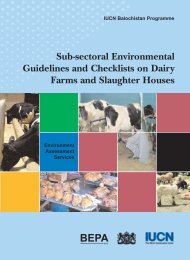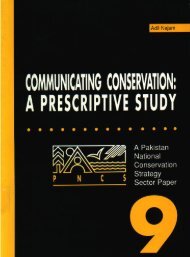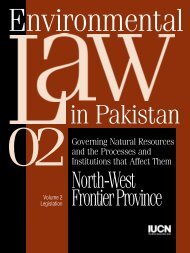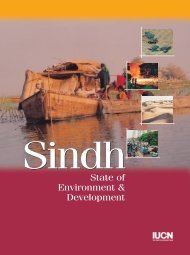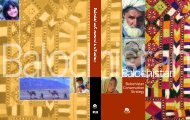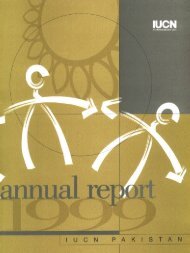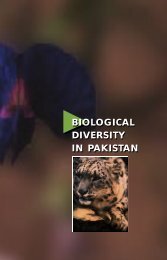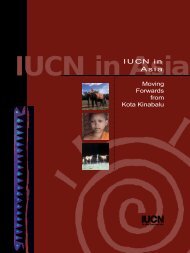Sustainable Fisheries - Pakistan Water Gateway
Sustainable Fisheries - Pakistan Water Gateway
Sustainable Fisheries - Pakistan Water Gateway
Create successful ePaper yourself
Turn your PDF publications into a flip-book with our unique Google optimized e-Paper software.
um and tin are less hazardous. There are also<br />
indications of heavy metal leaching from the<br />
<strong>Pakistan</strong> Steel Mills plant at Port Qasim.<br />
Domestic Waste<br />
The quantity of domestic waste per household in<br />
<strong>Pakistan</strong> varies from 80-280 litres per day. Most<br />
of this waste water is discharged into water bodies<br />
which eventually flow into the sea. Contaminated<br />
seawater poses health risks to swimmers<br />
and visitors to popular beaches.<br />
The saltwater creeks of the coast of Sindh also<br />
receive garbage and raw sewage from several<br />
fishing villages. The intertidal mud and sand flats<br />
in these creeks serve as defecating grounds for<br />
the villagers.<br />
However, organic pollution in the Manora<br />
Channel seems to have benefited the mangrove<br />
forests, which are thriving.<br />
In Balochistan, all organic waste and pollutants<br />
reach the sea untreated. However, in view<br />
of the vastness of the coastline and the open-sea<br />
condition of the receiving waters, large-scale<br />
dilution occurs making these wastes less of a<br />
problem.<br />
Human and domestic wastes can be sources<br />
of nutrients in coastal waters — nutrients<br />
increase the productivity of a body of water —<br />
and are a beneficial addition to the marine environment<br />
as they increase fish production.<br />
Upsloping, which occurs along the coast, transports<br />
nutrients from the lower levels of the sea to<br />
the surface. However, excessive nutrient loading<br />
can cause marine pollution through eutrophication<br />
— excessive phytoplankton production eventually<br />
leads to BOD problems as dead plants sink<br />
to the seabed and decay, depriving marine life of<br />
oxygen. Too many nutrients in coastal waters<br />
also lead to 'blooms' of toxic phytoplankton.<br />
Shellfish feeding on these blooms may absorb<br />
the toxic chemicals and be affected; if consumed<br />
by humans, the toxins in the seafood lead to<br />
paralysis, nervous disorders and respiratory disturbances.<br />
Fish kills have also been reported.<br />
Air Pollution<br />
Karachi and its suburbs suffer from acute air<br />
pollution, from dust and from the burning of<br />
kerosene oil, coal and sulphur along with firewood<br />
in residential and industrial areas. Carbon<br />
dioxide generation beyond the absorptive<br />
capacity of the city's environment can reduce the<br />
pH of adjoining waters, leading to an increase<br />
in the bicarbonate content of seawater, which is<br />
harmful to shellfish growth.<br />
Thermal Pollution<br />
Hot water discharges from power plants such as<br />
the Karachi Nuclear Power Plant (KANUPP), and<br />
plants owned by the Steel Mills and the Karachi<br />
Electric Supply Corporation affect the fauna and<br />
flora immediately around the outfall; but since<br />
the emission is relatively small compared to the<br />
receiving environment, the damage is localised.<br />
Radioactive Waste<br />
The major source of artificial radioactivity on the<br />
coast is KANUPP. It undertakes periodic monitoring<br />
of radioactivity in the environment through<br />
surveys of the surrounding grass and soil material.<br />
These have shown that radioactivity in the<br />
local waters has not increased. A second, much<br />
larger, nuclear power plant is being built<br />
upcountry near Chashma in the Mianwali district.<br />
Some radioactivity may reach the coastal waters<br />
of <strong>Pakistan</strong> through this source, via the Indu, but<br />
the levels are expected to be insignificant.<br />
Oil Pollution<br />
Evidence of oil pollution is found in the form of<br />
tar-balls on certain beaches all along the coast.<br />
The sandy and rocky intertidal zones at Gadani<br />
are smeared with oil which flow from the oil<br />
tanks of vessels scrapped at the ship-breaking<br />
yard. The intertidal area in the vicinity of the oil<br />
refineries along Korangi and Gizri creeks are<br />
also blackened with oil.<br />
Although a great deal of oil pollution is present<br />
in the Manora Channel (flushed daily by the<br />
tide) virtually no trace can be found along the<br />
beaches in the vicinity of the channel. This may<br />
be due to the large-scale dilution which occurs<br />
along the water course before the effluent<br />
reaches the Arabian Sea and/or because of the<br />
direction of the current.<br />
The Indus Delta is located at a safe distance<br />
NCS SECTOR PAPER 11




